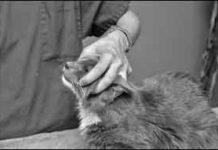Those Lovely Lilies? Theyre Lethal
A touch of green around the house during a long, cold winter provides a reminder of spring and creates a festive mood for the holidays. Although plants like lilies are lovely, the effects on a cat who ingests them are decidedly not. In the case of lilies of the Lilium species, cats can suffer potentially fatal kidney failure.
Short Takes: November 2014
Estimates are that osteoarthritis affects 90 percent of cats over the age of 12 years. Confirmation of the disease, however, can sometimes prove elusive. In the search for an accurate diagnosis, the Winn Feline Foundation has awarded a grant, funded by the animal health company Zoetis, to researchers at the University of Melbourne. Their goal is to develop a blood test biomarker - a molecule indicating an abnormal process - so the disease can be identified earlier.
The Team Approach to Success
Steffi Loomis awoke in the middle of the night to the sound of painful meows from Dave, her normally mellow 16-year-old female cat with a male name. When Loomis turned on the light, she discovered bloody diarrhea and vomiting and her orange tabby getting weaker and sicker by the minute. Loomis, who lives in New Canaan, Conn., contacted the veterinarian, who advised her to take Dave immediately to Cornell University Veterinary Specialists in nearby Stamford, Conn. CUVS, the largest university-affiliated veterinary referral service in the country, has been referred to as the Mayo Clinic of veterinary medicine. Loomis rushed Dave there, and a team of specialists quickly worked to save her life.
Shelter Help Desk Reduces Admissions
When behavior problems seem insurmountable, many owners surrender their pets to shelters. The Nevada Humane Society in Reno lowered admissions by 8 eight percent with one simple change: It created the Animal Help Desk, a free phone service. “We see it as part of our mission to encourage and enable people to do right by their animals by helping them keep their pets in their homes whenever possible,” Executive Director Bonney Brown says in the e-newsletter No-Kill Nation from Maddie’s Fund.
Slowing Feline Cognitive Decline
Advances in veterinary medicine are keeping our cats alive longer, giving us precious extra years to spend with them. Sadly, extended life-spans also bring geriatric disorders such as feline cognitive dysfunction (FCD), similar to human Alzheimer’s in its symptoms. Like Alzheimer’s, FCD has no cure. And far fewer studies have been done on the feline version of the disease than have been done on the canine variety, so there are no approved medical treatments. But antioxidant supplements, along with mental and physical exercise, often improve the quality of life for both owners and cats.
Robo-Tuffy Provides Hands-on Training
Students honing their emergency skills at the Cornell University College of Veterinary Medicine owe gratitude to a special feline named Fluffy, who doesn’t meow and never needs a litter box. Fluffy is a robotic cat equipped with a mechanical pulse and heart, artificial lungs and electronic hardware and software capable of simulating cardiac arrest, lung diseases, shock and other medical conditions. She and a canine version named Jerry are believed to be the first of their kind used in veterinary schools. Think of Fluffy as a high-tech pet version of the popular battery-operated board game Operation, which tests players’ hand-eye coordination and motor skills.
Protecting Against a Deadly Virus
Young kittens may seem fearless when they demonstrate their acrobatic talents during play, but they’re no match for the potentially deadly disease feline panleukopenia. Sometimes referred to as feline distemper, the disease is caused by the feline panleukopenia virus (FPV). The highly contagious, hard-to-kill virus can spread from infected cats or kittens to other kittens or adult cats who haven’t been vaccinated against it. In addition, recent studies confirm that there has been crossover of the infectivity between cats and newer types of parvovirus usually found in dogs. Parvo Crossover. While some newer canine parvovirus strains can transmit the viral disease to unvaccinated cats, this does not appear to cause disease in most cases, and also does not appear to occur at a rate to cause alarm because the current vaccines used in cats provide protection.
You Can Prevent This Serious Disease
If you’ve resisted brushing your cat’s teeth, knowing how strenuously he’s likely to object, consider this: Periodontal disease, an often painful inflammation of the gums that can result in bone loss and destruction of oral tissue, is extremely common. In fact, it’s the most prevalent disease in companion animals and can pose serious health threats. “Periodontitis has been shown to play a role in such health problems as cardiovascular disease and diabetes,” says dental specialist Santiago Peralta, DVM, a Lecturer in Dentistry and Oral Surgery at the Cornell University College of Veterinary Medicine. This disease is, however, entirely preventable, according to the American Veterinary Dental College (AVDC). The best way to prevent periodontitis is by regular brushing and professional dental care.
Toward More Accurate Diagnoses of Sarcomas
Researchers at North Carolina State University are hoping for a breakthrough in a study designed to distinguish spontaneous sarcomas from injection site-associated sarcomas (ISASs). Each year about 22,000 cats in the U.S. appear to develop sarcomas, or malignant tumors, at the site of a vaccination or other injection, according to the Morris Animal Foundation, which is funding the study. The more aggressive ISASs often recur. Identifying a sarcoma in its early stages “could provide crucial information to help guide the owner and veterinarian as the best approach to treatment, and in the longer term, help us to understand why these tumors occur,” says Rachael Thomas, Ph.D., leader of the research team
Be Patient but Purposeful When Giving Medicine
You sigh with relief after the veterinarian examines your ailing cat and tells you that he’ll make a complete recovery. But then the veterinarian brings out a bottle of pills and begins giving you instructions on administering the right dose each day. Suddenly, you panic as you envision a struggle between you and your cat about pills or potions. It doesn’t have to be that way. Giving medicine can be easily accomplished by performing the correct steps in the right sequence; and here to help you master that procedure are Margaret Schnellinger, Licensed Veterinary Technician and LVT Team Leader at the Cornell University Hospital for Animals, and behaviorist Sophia Yin, DVM, in private practice in Davis, Calif. Dr. Yin is also the author of “Low Stress: Handling, Restraint and Behavior Modification of Dogs & Cats” (CattleDog Publishing), a resource with more than 1,600 how-to photographs for veterinarians and veterinary technicians.
In The News: The Risks of Upper Respiratory Infections
Signs that your cat has an infection of his upper respiratory tract can mimic the ones you suffer with a cold: watery eyes, runny nose, wheezing, sneezing and coughing. Just as you’re likely to rebound in a few days, in most instances a cat will, too.
The Future Basis For Diet Plans: Genetics
Nutritionist Joseph Wakshlag, DVM, Associate Professor of Clinical Nutrition at Cornell University College of Veterinary Medicine, poses a question for owners: “If you knew that your cat would develop cognitive dysfunction at age 12, and if feeding him an antioxidant-enhanced diet would delay that development, wouldn’t you do it?” That scenario may be possible in the not-too-distant future. If scientists identify a gene for feline cognitive dysfunction — and a host of other diseases with genetic risk factors — individualized nutrition and lifestyle plans could be developed for cats based on their genetic tests. It has long been known that nutrition plays an important role in preventing and healing disease in humans, cats and dogs, but its role may be greater than we thought. Researchers in the pioneering science of nutrigenomics stand squarely at the intersection of genetics and nutrition.
















